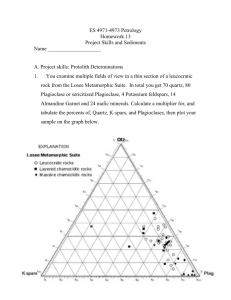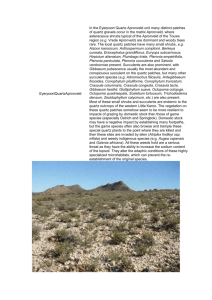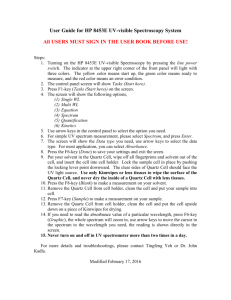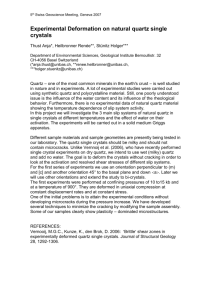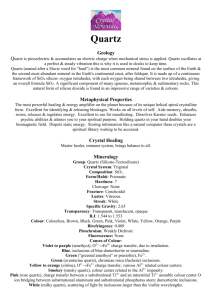the Scanned PDF
advertisement
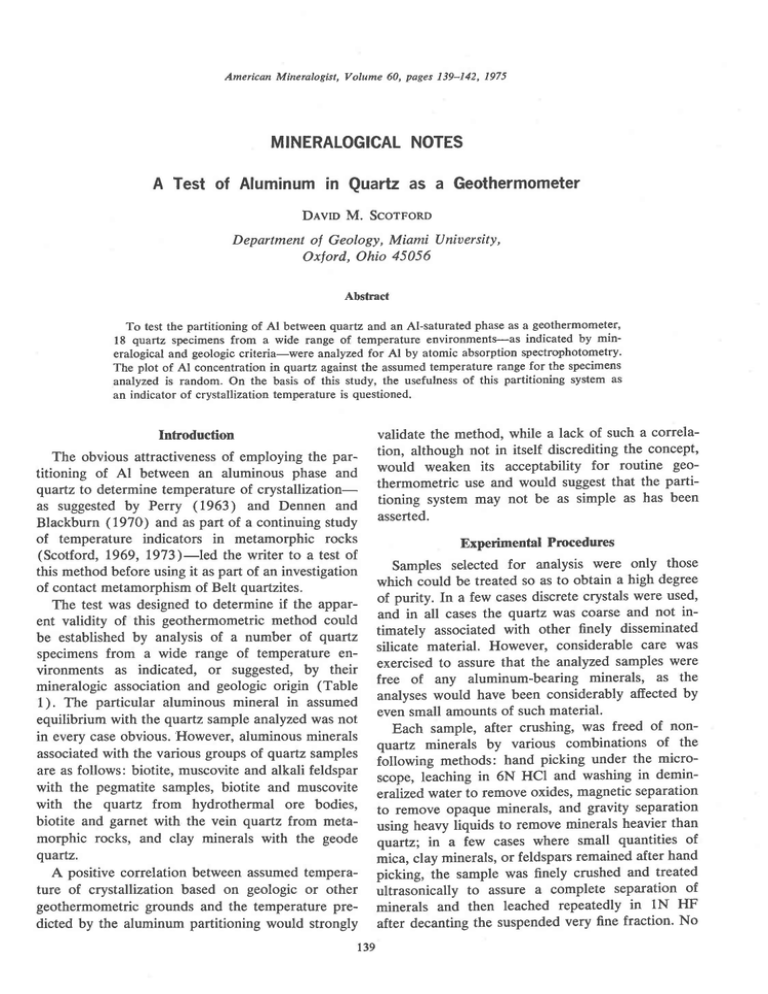
American Mineralogist, Volume 60, pages 139-142, 1975
MINERALOGICAL
NOTES
A Test of Aluminumin Quartz as a Geothermometer
Dlvro M. Scorrono
Department of Geology, Miami Unirsersity,
Oxford, Ohio 45056
Abstract
To test the partitioning of Al between quartz and an Al-saturated phase as a geothermometer,
18 quartz specimens from a wide range of temperature environments-as indicated by mineralogical and geologic criteria-were analyzedfor Al by atomic absorption spectrophotometry.
The plot of Al concentration in quartz against the assumedtemperature range for the specimens
analyzed is random. On the basis of this study, the usefulness of this partitioning system as
an indicator of crystallization temperature is questioned.
Introduction
The obvious attractivenessof employing the partitioning of Al between an aluminous phase and
qtartz to determinetemperatureof crystallizationas suggestedby Perry (1963) and Dennen and
Blackburn (1970) and as part of a continuing study
of temperature indicators in metamorphic rocks
(Scotford, 1969, 1973)-led the writer to a test of
this methodbefore using it aspart of an investigation
of contactmetamorphismof Belt quartzites.
The test was designedto determineif the apparent validity of this geothermometricmethod could
be establishedby analysis of a number of quartz
specimensfrom a wide range of temperature environments as indicated, or suggested,by their
mineralogic associationand geologic origin (Table
1). The particular aluminous mineral in assumed
equilibrium with the quartzsampleanalyzedwas not
in every caseobvious.However, aluminousminerals
associatedwith the various groupsof quartz samples
are as follows: biotite, muscoviteand alkali feldspar
with the pegmatite samples,biotite and muscovite
with the quartz from hydrothermal ore bodies,
biotite and garnet with the vein quartz from metamorphic rocks, and clay minerals with the geode
qnafiz.
A positive correlation betweenassumedtemperature of crystallization based on geologic or other
geothermometricgrounds and the temperaturepredicted by the aluminum partitioning would strongly
validate the method. while a lack of such a correlation, although not in itself discreditingthe concept,
would weaken its acceptability for routine geothermometric use and would suggestthat the partitioning system may not be as simple as has been
asserted.
Experinental Procedures
Samples selected for analysis were only those
which could be treated so as to obtain a high degree
of purity. In a few casesdiscretecrystalswere used,
and in all casesthe quartz was coarse and not intimately associatedwith other finely disseminated
silicate material. However, considerablecare was
exercisedto assurethat the analyzedsampleswere
free of any aluminum-bearing minerals, as the
analyseswould have been considerablyaffectedby
evensmall amountsof suchmaterial'
Each sample, after crushing, was freed of nonquartz minerals by various combinations of the
following methods: hand picking under the microscope, leaching in 6N HCI and washing in demineralizedwater to removeoxides,magneticseparation
to remove opaque minerals, and gravity separation
using heavy liquids to removemineralsheavier than
quartz; in a few cases where small quantities of
mica, clay rninerals,or feldsparsremainedafter hand
picking, the sample was finely crushed and treated
ultrasonically to assure a complete separation of
minerals and then leached repeatedly in lN HF
after decantingthe suspendedvery fine fraction. No
139
140
MINERALOGICAL
Tesre 1. Al Concentration in Quartz Specimensfrom
Various Thermal Envirnoments
Spec,
No.
SpeciDen origin
Tenpelatue
and Probable
Enviroment
DupLicated Analyses of
Af in Quartz in ppn
fron rhyolite,
E quartz crystal
Judith Mts., Montana,
573-867oC
\DOSne, IyO)r p. JO,'
Peg@tite,
Beryl 14t,, tl.tt.
5OO-5OOoC
nost probable
tenperature
range
(Jahns ed Burnh@, 1969 )
Pegmatite,
(Jilns
ud
Devils
bwMm,
l+38
Hole, Colorado.
tyoy./
\l{2
Pegmtite,
lGyers Rmch, Colorado.
anq tsrM@t
l9oy J
\J&ns
Pegmtite,
Custer,
Burnh@, 1969)
S.D.
Pegmtite,
Bunhd,
I'faine .
Albarry,
1959)
(Jahns
and
(Jehns
Hydrothemal
ore bo{y,
Broken
Nev South WaLes.
100-630oC
a
L
,
e
t
I
y
)
u
ilc
\uusrarson,
Rudohr,1950)
23L
ed
flifl,
27?
)Ao
Hypothemal
ore body, Homestshe, S.D,
tenperature
300-600oC host probable
in upper portion
of tedperature
rdge
(Ridse,1972)
Hypothemal
ole body, Cfioax,
Colo.
Probably
30o-bo0"C (Ridge, I9T2)
closer,to
lover
of tenperature
-end^
.
ryJ5/
range (nrngewuc,
qusrtz
veib in gdnet
zone neta@rphic
rocks, Three Top Mt., N.C.
estlnatetl
on
300-lr00oc, te4peratue
basis of assued
segregation
origin
zone netaQuartz vein in garnet
norphic rocks, West Jeffersoo,
N.C.
3OO-!OOoC, tenperature
estimateal on
basis of assued
segregation
origin
L2
Mesothemol
ore body, Noranda, Quebec.
Specimen froB hydrothemaL
zone.
zuu-J)u'u \r1dge, Iy Jz,
13
l4esothemaL
ore body, Butte,
l.tontana.
200-325oc (Meyer, et a1., 1958)
j.n 1ov
Ilydrothemal
qustz
crystal-s
grade neteo4)hic
rocks near Littte
(Miser
Rock, Arkesas.
100-3OOoC
and
Milton,
1!51+)
2r1.
("Herkemer
crystafs
Dircnd"
Qudtz
)
precipitated
at neu
surface tenperatue,
Herkerner,
N.Y. (Frondef,
1952)
quutz
Srface
crystals
ln
teEperatue
geode, Kentucky.
(Jackson, f97o)
rB
quartz
Suface
crystals
in
teEperatre.
geode,
Indiana.
not yield the sameanalytical result, it was assumed
the inhomogeneitywas probably due to impurity and
the samplewas discarded.
The Al content of the quaftz was determined
using a Perkin-Elmer Model 303 atomic absorption
spectrophotometerwith nitrous oxide as oxidant and
acetylenefuel. Sampleswere analyzedin groups of
three to six togetherwith a contaminationblank and
the NBS (National Bureau of Standards)standard198 Silica Refractory. To repressAl ionization, 500
ppm K was added to both sample and standard
solutions.
The accuracy of the analyseswas evaluated by
comparing those here obtained for the NBS 198
standardwith those quoted by the National Bureau
of Standardfrom other laboratories.The averageof
12 analysesquoted by NBS is 0.160 wt percent
AlzOe. The mean of 11 analysesobtained in this
study is 0.145, indicating a probable accuracyof
betterthan :t10 percent.
The reproducibility of the analyseswas established by duplicate analysis of all samplesexcept
one (No. 1) for which insufficient sample was
available. The data (Table 1) show a maximum
uncertainty of 7 percent, with most analysesagreeing within lessthan 5 percentof the amountpresent.
Results
TeletherDol
ore body, Galena, Kdsos.
83-12OoC, based on fluid
inclusaons
(Schnidt,
in sphaferite
1!62)
I7
NOTES
l!\2
samplewas acceptedfor analysisunlessmicroscopic
examination after treatment revealed no silicate
impurity.
An additional test of purity was provided by the
standard of reproducibility required before the
analytical data were acceptedfor inclusion in this
study. If the two aliquots of the same sample did
The duplicate analysesof Al in the quartz specimensis shownin Table I togetherwith the specimen
origin and probable temperaturerange. These data
are plotted graphically on Figure 1. The probable
temperaturerange of each specimenis indicated by
the vertical line while the crossing horizontal line
is the error bar relating to the duplicateAl analyses.
The intersectionof the two lines representsthe best
temperatureestimatefor that sample.
Also plotted on Figure 1 is the curve of Dennen
and Sfickburn (1970) which relates temperature
to Al in quaftz. It is obvious that no linear relationship exists between the probable temperature of
crystallization and Al concentration in the quartz
samplesanalyzedin this study.
Conclusions
The lack of any linear relationship between the
Al content of quartz and the apparent temperature
of crystallizationbasedon mineralogic and geologic
evidencewould seemto bring the utility of the Alqvartz geothermometer into question. Using 10
samples,Dennen and Blackburn (1970, p. 34I)
MINERALOGICAL
T"C
ppm Al
Frc. l. Plot of the Al in numbered quartz specimens os
temperature (see Table 1). Error bars indicate probable
limit of error for temperatue and Al concentation. Intersection of error bars is most probable temperatue and Al
concentation. Sloping lines are from the least squares regression of Dennen and Blackbprn (1970) for Al in quartz
0s temperature.
found that four, all granitic rocks, did not fall at
reasonabletemperature values when their Al concentrations were plotted on the Al in qrartztemperature curve. They suggestedthat the consistently low temperatures obtained by this plot
might reflect the late intergranular concentrationor
recrystallizationof qtartz in a subsolidusreaction.
However, in this study only three or possibly four
out of 18 analysesfall anywhereon the Dennen and
Blackburncurve (Fig. 1).
Fossibleexplanationsof the discrepancies
between
the presentstudy and that of Dennenand Blackburn
are consideredbelow. As all but four analyseshave
an Al content higher than can be plotted on the
Dennen and Blackburn curye, the possiblepresence
of a non-silica source of Al in the sample is sug-
NOTES
141
gested.However, as described above, considerable
care was taken in the selection and preparation of
the samples analyzed to assure their purity. An
alternateexplanationof the higher Al concentration
found in this study may be the differencein analytical method. The analysesdone in the Dennen and
Blackburn study were by emissionspectrographyin
which analytical precision, accordingto the writers,
was not high, the coefficientof variation being about
20 percent, and no test of accuracycould be made.
The atomic absorption spectrophotometricmethod
used in the presentstudy provided a reproducibility
to within lessthan 7 percentand an accuracyevaluation establishedby comparison with an analyzed
standard of :L less than 10 percent of the amount
present.
The theory of Al partitioning betweenquartz and
an Al-bearing mineral as a function of temperature
requiresthe presenceof an Al-saturated phase.The
presence or absenceof such a phase within the
equilibrium domain during crystallizationcannot always be establishedpetrographicallyin a solidified
rock. Thus, some quartz (e.g., from geodes) employed in this study may not have acquiredtheir Al
content by participation in such an equilibrium.
To the writer the most reasonableconclusionto
the present study is that the Al content in quartz
is not simply a function of its temperatureof crystallization and cannot be used as a reliable geothermometer.Insteadthis A1 contentmay alsobe affected
by the presenceof other elementsparticipating in
the equilibrium of the systemor by the substitution
of Al not only into the tetrahedralsitesof the quartz
structure but also into the more open spacesin the
structure.
Acknowledgments
This study was supported by a research grant from
Miami University.
References
DENNEN,W. H., erto W. H. Brecreunw (1970) Aluminum
in quartz as a geothermometer. Conffib. Minetal. Petrol
27,332-342.
GustersoN, J. K., H. E. Bunnerr., eNo M. D' Gennerrv
(1950) Geology of the Broken Hill ore deposit N.S'W.'
Australia. Geol. Soc. Am. Bull. 61, 1369-1437.
JerrNs, R. H., luo C. W. BunNrreu (1969) Experimental
studies of pegmatite genesis: I. A model for the derivation and crystallization of granitic pegmatites. Econ.
Geol. 64, 843-864.
MevER, C., E. P. Sune, eND C. C. Goooeno (1968) Ore
deposits of Butte, Montana. In, P. T. Ridge, Ed'' Ore
142
MINERALOGI,CAL
Deposits of the U.S. 1933-1967. Am. Inst. Min. Metall.,
Vol. 11, New York.
Mrsen, H. D., eNo C. MrlroN (1964) Quartz, rectorite, and
cookeite from Jefferson quarry near North Little Rock,
Pulaski County, Arkansas. Arkansas Geol. Comm. Bull.
21.
Pennv, E. C., JR. (1963) Aluminum Substitution in Quartz,
A Study in Geothermometry. Ph.D. Thesis, Massachusetts
Institute of Technology, Cambridge, Massachusetts,86 p.
RAMDoHR,Peur (1950) Die Lagerstdtte von Broken Hill in
New South Wales im suchungen. Heidelberger Beitr. zur
Mineral. und Petrol. 2. 291-333.
Rncr, J. D. (19'72) Annotated bibliographies of mineral
deposits in the Western Hemisphere, Geol. Soc. Am.
Mem.3l.
NOTES
Scorrono, D. M. (1969) Metasomatic augen gneiss in
greenschist facies, western Turkey. GeoI. Soc. Am. BuIl.
80, tO79-1W4.
(1973) Strontium partitioning between coexisting
K-feldspar and plagioclase as an indicator of metamorphic grade in southwestern New Hampshire. GeoI.
Soc. Am. BulI. E4,3986-3994.
Srwcrweto, L T. (1933) Genetic group of hypogene deposits in tlre Western U.S. In, Ore Deposits in the Western
States. Am. Inst. Min. Metall., New York.
SosMeN, RosBnr B. (1965) The Phases of Silica. Rutgers
University Press, New Brunswick, New Jersey, 381 p.
Manuscript receioed, Iuly 19, 1974; accepted
lor publication, October I, 1974.


